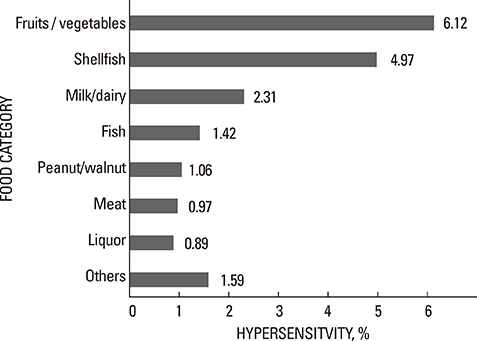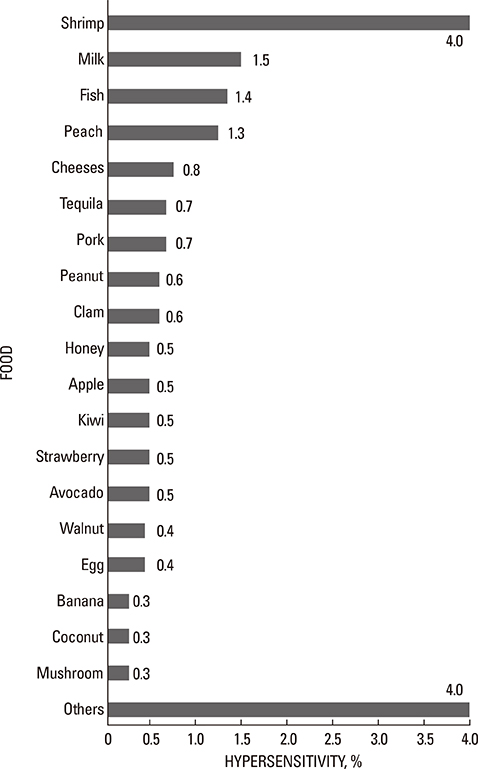Allergy Asthma Immunol Res.
2014 Nov;6(6):511-516. 10.4168/aair.2014.6.6.511.
Food Hypersensitivity in Mexican Adults at 18 to 50 Years of Age: A Questionnaire Survey
- Affiliations
-
- 1Allergy and Clinical Immunology Service, The "Dr. Juan I. Menchaca" Civil Hospital of Guadalajara, Guadalajara, Mexico. drmbedbar@gmail.com
- 2Guadalajara Lamar University. Guadalajara, Jalisco, Mexico.
- 3UTEG University. Guadalajara, Jalisco, Mexico.
- 4Public Health Institute, University of Veracruz. Xalapa, Veracruz, Mexico.
- KMID: 2260173
- DOI: http://doi.org/10.4168/aair.2014.6.6.511
Abstract
- PURPOSE
There is limited epidemiological evidence of food hypersensitivity (FH) in the adult population. We aimed to determine the prevalence of FH in Mexican adults, their clinical features and to establish common food involved in its appearance.
METHODS
We designed a cross-sectional study using a fixed quota sampling; 1,126 subjects answered a structured survey to gather information related to FH.
RESULTS
The prevalence of FH in adults was 16.7% (95% CI, 14.5% to 18.8%), without statistical significant differences related to gender (women, 17.5% and men, 15.9%) or residential location. The most common clinical manifestations in adults with FH were oral allergy syndrome (70 of 1,126) and urticaria (55 of 1,126). According to category, fruits and vegetables were the most frequent foods to trigger FH (6.12%) and were individually related to shrimp (4.0%), and cow milk (1.5%). Adults under age 25 had a higher frequency of FH (OR, 1.39; 95% CI, 1.01 to 1.91, P <0.001). Personal history of any atopic disease was significantly associated with FH (P <0.0001).
CONCLUSIONS
The prevalence of FH is relatively high in Mexican adults, and FH is significantly associated with atopic diseases.
Keyword
MeSH Terms
Figure
Cited by 1 articles
-
Self-reported prevalence of clinical features of allergy to nuts and seeds, and seafood in university students
Ma. Victoria Domínguez-García, Miriam V. Flores-Merino, Cecilia Puente-Fernández, Jaime Morales-Romero, Martín Bedolla-Barajas
Asia Pac Allergy. 2018;8(2):. doi: 10.5415/apallergy.2018.8.e19.
Reference
-
1. Johansson SG, Hourihane JO, Bousquet J, Bruijnzeel-Koomen C, Dreborg S, Haahtela T, Kowalski ML, Mygind N, Ring J, van Cauwenberge P, van Hage-Hamsten M, Wüthrich B. EAACI (the European Academy of Allergology and Cinical Immunology) nomenclature task force. A revised nomenclature for allergy. An EAACI position statement from the EAACI nomenclature task force. Allergy. 2001; 56:813–824.2. Hu Y, Chen J, Li H. Comparison of food allergy prevalence among Chinese infants in Chongqing, 2009 versus 1999. Pediatr Int. 2010; 52:820–824.3. Rona RJ, Keil T, Summers C, Gislason D, Zuidmeer L, Sodergren E, Sigurdardottir ST, Lindner T, Goldhahn K, Dahlstrom J, McBride D, Madsen C. The prevalence of food allergy: a meta-analysis. J Allergy Clin Immunol. 2007; 120:638–646.4. Strobel S. Epidemiology of food sensitivity in childhood--with special reference to cow's milk allergy in infancy. Monogr Allergy. 1993; 31:119–130.5. Jansen JJ, Kardinaal AF, Huijbers G, Vlieg-Boerstra BJ, Martens BP, Ockhuizen T. Prevalence of food allergy and intolerance in the adult Dutch population. J Allergy Clin Immunol. 1994; 93:446–456.6. Altman DR, Chiaramonte LT. Public perception of food allergy. J Allergy Clin Immunol. 1996; 97:1247–1251.7. Sampson HA. Epidemiology of food allergy. Pediatr Allergy Immunol. 1996; 7:42–50.8. Young E, Stoneham MD, Petruckevitch A, Barton J, Rona R. A population study of food intolerance. Lancet. 1994; 343:1127–1130.9. Schäfer T, Böhler E, Ruhdorfer S, Weigl L, Wessner D, Heinrich J, Filipiak B, Wichmann HE, Ring J. Epidemiology of food allergy/food intolerance in adults: associations with other manifestations of atopy. Allergy. 2001; 56:1172–1179.10. Sloan AE, Powers ME. A perspective on popular perceptions of adverse reactions to foods. J Allergy Clin Immunol. 1986; 78:127–133.11. Falcão H, Lunet N, Lopes C, Barros H. Food hypersensitivity in Portuguese adults. Eur J Clin Nutr. 2004; 58:1621–1625.12. Vierk KA, Koehler KM, Fein SB, Street DA. Prevalence of self-reported food allergy in American adults and use of food labels. J Allergy Clin Immunol. 2007; 119:1504–1510.13. Marrugo J, Hernández L, Villalba V. Prevalence of self-reported food allergy in Cartagena (Colombia) population. Allergol Immunopathol (Madr). 2008; 36:320–324.14. Gelincik A, Büyüköztürk S, Gül H, Işik E, Işsever H, Ozşeker F, Colakoğlu B, Dal M, Ayvaz O, Güngör G, Akkor A. Confirmed prevalence of food allergy and non-allergic food hypersensitivity in a Mediterranean population. Clin Exp Allergy. 2008; 38:1333–1341.15. Zeiger RS, Heller S. The development and prediction of atopy in high-risk children: follow-up at age seven years in a prospective randomized study of combined maternal and infant food allergen avoidance. J Allergy Clin Immunol. 1995; 95:1179–1190.16. Woods RK, Abramson M, Bailey M, Walters EH. International prevalences of reported food allergies and intolerances. Comparisons arising from the European Community Respiratory Health Survey (ECRHS) 1991-1994. Eur J Clin Nutr. 2001; 55:298–304.17. Zuberbier T, Edenharter G, Worm M, Ehlers I, Reimann S, Hantke T, Roehr CC, Bergmann KE, Niggemann B. Prevalence of adverse reactions to food in Germany-a population study. Allergy. 2004; 59:338–345.18. Soller L, Ben-Shoshan M, Harrington DW, Fragapane J, Joseph L, St Pierre Y, Godefroy SB, La Vieille S, Elliott SJ, Clarke AE. Overall prevalence of self-reported food allergy in Canada. J Allergy Clin Immunol. 2012; 130:986–988.19. Boye JI. Food allergies in developing and emerging economies: need for comprehensive data on prevalence rates. Clin Transl Allergy. 2012; 2:25.20. Katelaris CH. Food allergy and oral allergy or pollen-food syndrome. Curr Opin Allergy Clin Immunol. 2010; 10:246–251.21. Osterballe M, Hansen TK, Mortz CG, Høst A, Bindslev-Jensen C. The prevalence of food hypersensitivity in an unselected population of children and adults. Pediatr Allergy Immunol. 2005; 16:567–573.22. Eriksson NE, Möller C, Werner S, Magnusson J, Bengtsson U, Zolubas M. Self-reported food hypersensitivity in Sweden, Denmark, Estonia, Lithuania, and Russia. J Investig Allergol Clin Immunol. 2004; 14:70–79.23. Alvarado MI, Pérez M. Study of food allergy in the Spanish population. Allergol Immunopathol (Madr). 2006; 34:185–193.24. Sicherer SH, Muñoz-Furlong A, Sampson HA. Prevalence of seafood allergy in the United States determined by a random telephone survey. J Allergy Clin Immunol. 2004; 114:159–165.25. Bahna SL. Cow's milk allergy versus cow milk intolerance. Ann Allergy Asthma Immunol. 2002; 89:56–60.26. Yoneyama K, Ono A. Study of food allergy among university students in Japan. Allergol Int. 2002; 51:205–208.27. Ehlers I, Hipler UC, Zuberbier T, Worm M. Ethanol as a cause of hypersensitivity reactions to alcoholic beverages. Clin Exp Allergy. 2002; 32:1231–1235.28. Nakagawa Y, Sumikawa Y, Nakamura T, Itami S, Katayama I, Aoki T. Urticarial reaction caused by ethanol. Allergol Int. 2006; 55:411–414.29. Wigand P, Blettner M, Saloga J, Decker H. Prevalence of wine intolerance: results of a survey from Mainz, Germany. Dtsch Arztebl Int. 2012; 109:437–444.30. Bedolla-Barajas M, Morales-Romero J, Ortiz-Miramontes LR, Jáuregui-Franco RO. Frequency and clinical features of the oral allergy syndrome in Mexican adults with nasal pollinosis. Rev Alerg Mex. 2013; 60:17–25.31. Cianferoni A, Muraro A. Food-induced anaphylaxis. Immunol Allergy Clin North Am. 2012; 32:165–195.32. Imamura T, Kanagawa Y, Ebisawa M. A survey of patients with self-reported severe food allergies in Japan. Pediatr Allergy Immunol. 2008; 19:270–274.33. Kanny G, Moneret-Vautrin DA, Flabbee J, Beaudouin E, Morisset M, Thevenin F. Population study of food allergy in France. J Allergy Clin Immunol. 2001; 108:133–140.34. Lack G. Epidemiologic risks for food allergy. J Allergy Clin Immunol. 2008; 121:1331–1336.35. Lunet N, Falcão H, Sousa M, Bay N, Barros H. Self-reported food and drug allergy in Maputo, Mozambique. Public Health. 2005; 119:587–589.
- Full Text Links
- Actions
-
Cited
- CITED
-
- Close
- Share
- Similar articles
-
- Food allergic reactions in the community: a questionnaire survey of caregivers
- Self-reported prevalence of clinical features of allergy to nuts and seeds, and seafood in university students
- Food literacy and its relationship with food intake: a comparison between adults and older adults using 2021 Seoul Food Survey data
- Self-report prevalence and associated factors to drug hypersensitivity in Mexican young adults
- Food Allergy: Diagnosis and Management



